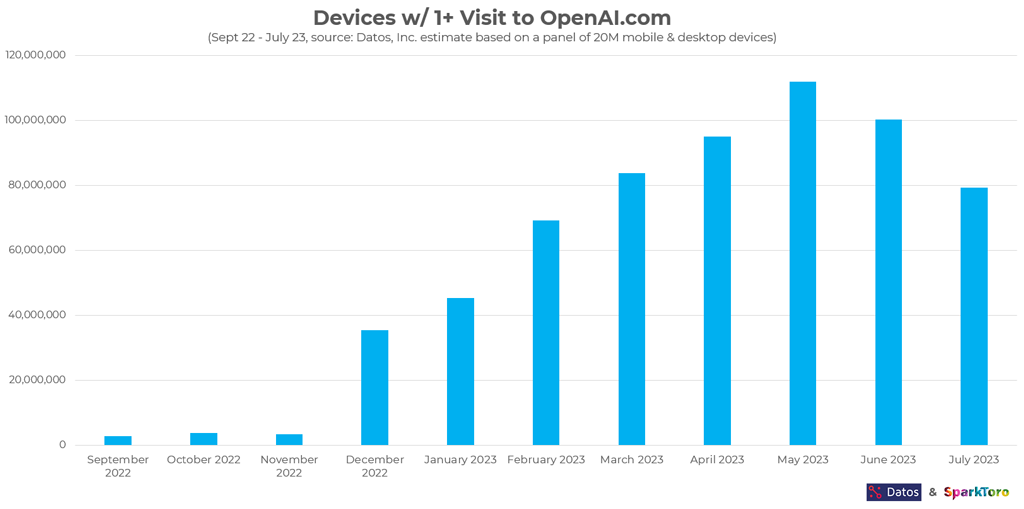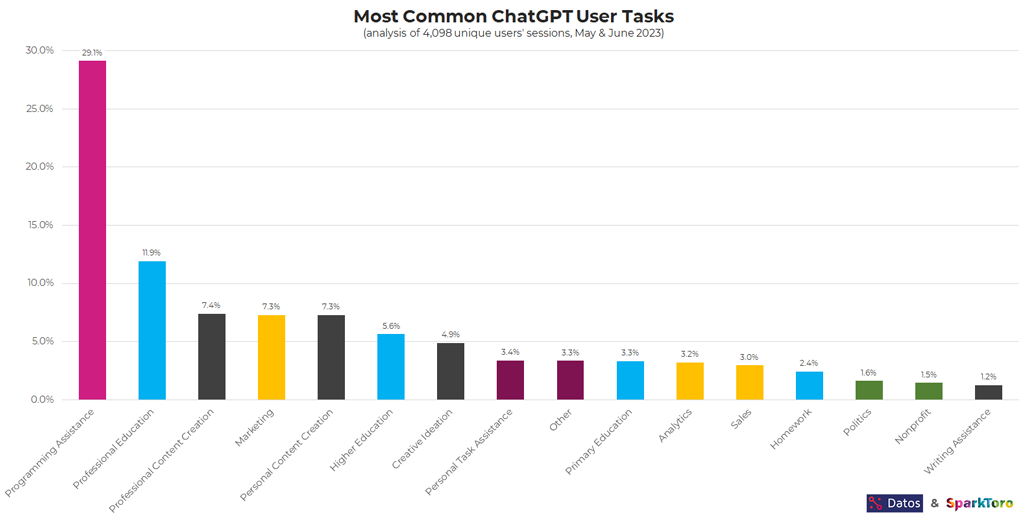ChatGPT and L&D
– Trends are showing searches for and use of ChatGPT and AI Services are slowing.
– General interest in these tools is waning, but professionals are expanding how they use these tools.
– Survey data shows that employees still want in-person training. ChatGPT data shows that professional education was the second most used task.
ChatGPT and L&D: A Quick Recap
If it felt like overnight we were overwhelmed with posts, news stories, and conversations about AI and ChatGPT, well, it’s because the adoption happened literally over a handful of nights.
It took five days for ChatGPT to reach 1 million users.
For reference, it took Facebook 10 months to reach the same level of users.

However, user traffic for Chat GPT has slowed down.
Now, don’t let this news fool you. There isn’t any indication that AI is becoming less integrated into our lives. Those who continue using ChatGPT are likely to use it for many more different types of tasks when they first started.
The data that is accessible today helps us peek into the potential future of how tools like ChatGPT will affect industries like Learning and development (L&D).
Recently, OpenAI reported that traffic to their sites has slowed by 29% from May to July 2023.

At its peak in May 2023, OpenAI, the creator of ChatGPT, reported that they had over 110,000,000 users using the service (that’s nearly ⅓ of the population of the United States).
The digital marketing platform, SparkToro believes that the downward trend is likely because there is a decline in casual users who wanted to get a taste of the tool, but found no real use for it.
Overwhelmingly, however, returning ChatGPT users are asking more than one prompt, and the range of words being used in the prompts that people ask is… interesting, to say the least.
Below is a visual representation of the number of times a certain word was used during a task prompt that was asked of ChatGPT. Some of the words may have you questioning how people are using a tool like ChatGPT:
A few words from this graphic that I found interesting were:
- Fun (used within 16% of prompts)
- Game (used in 4.6% of prompts)
- Tax (used in ~3% of prompts)
Clearly, the use cases of ChatGPT are expanding unless we should expect some fun games around taxes to hit the market in the near future. Look out April 2024!
That said, this graph continues to show that fields like Marketing and Programming continue to leverage ChatGPT to help them accomplish their work (Python, Factor, SEO, Write, etc).
ChatGPT and Professional Learning
SparkToro worked with Datos to understand what this data means and they were able to use ChatGPT to segment the data into the following categories:
Unsurprisingly, programming assistance garnered the highest amount of use. ChatGPT is advanced at understanding coding languages along with Microsoft Excel functions and SQL.
What was surprising is that Professional Education was the second most popular task employed by users of ChatGPT.
In August 2023, Wiley, the publisher of Everything DiSC, surveyed 3,000 working professionals and found similar data when asked if they preferred professional learning to be developed and delivered by a subject matter expert or AI technology.
Their survey found that, overwhelmingly, 87% of respondents still preferred a human to develop and deliver professional learning:

While it’s unsurprising that a large majority of respondents prefer having a human instructor for professional learning, it should be very surprising that there are as many people who prefer to learn professionally via AI since the general population has only had one summer of using tools like ChatGPT.
Statistics offers a model for some insight into what we may be entering: a J Curve. As people remain open to a new idea, product, or way of thinking, the rate of adoption will accelerate. What we experienced in May of this year was clearly a J Curve of adoption for tools like ChatGPT.
J Curve

Search Data for Chat GPT / AI

The question now becomes if the adoption of ChatGPT will continue to accelerate at the same rate we experienced this summer (or faster).
Additionally, if the adoption rate continues to accelerate, how will that affect a learner’s preference for AI instruction compared to a human instructor?
What is evident is that L&D teams should continue, or start, to find ways to engage in building ChatGPT-like tools for areas that could be easily outsourced.
Earlier this year, we wrote about how L&D Teams could leverage automation tools like Zapier to automate parts of a DiSC Training. By leveraging this tool, we focused more of our time on human interactions rather than the busy work that surrounds our DiSC Training.
Zapier now offers the ability for anyone to create a free chatbot. This tool was built with marketers in mind, but it could be easily leveraged by L&D teams who need to teach compliance or other similar type of courses.
While it’s still early in the timeline of AI Adoption, the data shows that our society is quickly adopting using AI tools for professional learning.


